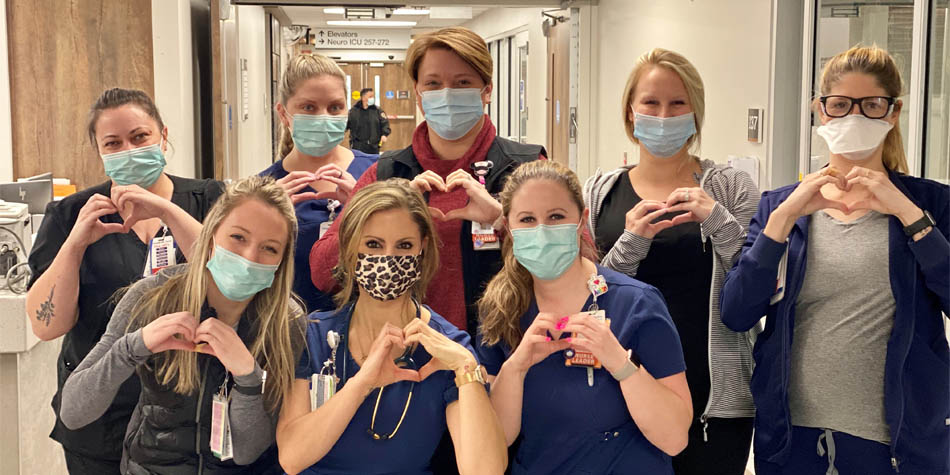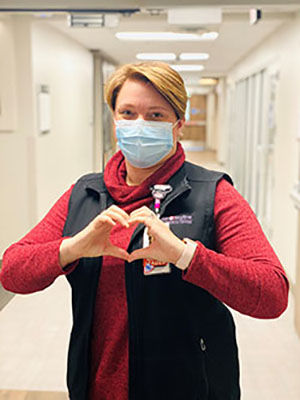
Nearly a year after the COVID-19 pandemic, going to the hospital can feel isolating. “There’s a high level of fear and anxiety when you can’t have someone at your bedside, especially in the elderly population,” says Christine, a Clinical Director at one of our TriStar hospitals. “We’re seeing a lot of couples who haven’t spent more than a few days apart from each other in their lives.” Christine, like many of our TriStar colleagues, has discovered that one of the most challenging aspects in the ongoing work to keep patients safe is how to help families and loved ones to stay connected during their hospital stay. “We are constantly asking, ‘What can we do to try to give some sense of normalcy among the restrictions?’” she says.
Since the beginning of the COVID-19 pandemic, Christine has seen major changes in how her team works to provide care to some of the hospital’s most vulnerable patients. Beyond the PPE and masking, she has also witnessed more kindness, caring, and community than ever before. “There’s been a real stepping up,” she says, “a sense that this is our calling, and this is what we need to do to care for our community.”
When it comes to creating a sense of normalcy, the staff continues to consider the ways they can ease any anxiety a patient might feel, especially when they aren’t able to have their loved ones at the bedside. “We’re always thinking a lot about communication,” Christine says. “The more we can talk with families and keep them updated, the more the anxiety can be alleviated. It’s a lot of emotion for patients, so we really think outside the box and think about how we can go about creating those connections. Can we FaceTime or Zoom? How can we help be what these people need during their stay and how can we provide that emotional support?” Christine shared that for many couples, having that reminder that there are people outside of the hospital who love them and care about their return inspires them to continue to fight to get well.
Sometimes, the staff goes beyond virtual communication to help families feel safe and comfortable. In Christine’s department, she witnessed an elderly gentleman, who at 90 years old was admitted to the hospital with COVID-19. He’d been married over 60 years, and his wife, who was 89, made sure to call the staff every day and check on his progress, and make sure he was eating and staying positive. “She told us she knew that if she could just visit him, she could encourage him so he would be strong enough to come home,” Christine says. She told the staff she needed to be at his bedside, and they immediately began to put their heads together to see how they could keep this couple connected.
Typically, visitors aren’t allowed in the COVID-19 unit, but the staff knew that the connection between the spouses could be enough to inspire healing. They tested the woman for COVID-19, and then helped her with the PPE she would need to wear while at the hospital. She was allowed to visit once a day, and she would sit by her husband’s bed, help feed him, talk to him, and hold his hand while reminding him that there were people outside of the hospital he needed to get well for. He went on to make a full recovery and was able to return home. Throughout every step of the journey, the staff made sure that the couple felt safe and informed.
In another instance, Christine and her staff looked after a man whose new wife wanted to be by his side throughout his care. These weren’t typical newlyweds though — he was 90 and she was 88. They’d met on a dating site three years earlier and had been inseparable ever since. When the man’s health declined, the staff at the hospital worked with his wife to track down and bring together the man’s family, both virtually and in person, so the family could all be together and make decisions about next steps. “The staff really wanted to focus on supporting the patient emotionally. They took the time to think ‘What if that was my dad? What would I want? How can I support those wishes?’” Christine says. As a result, the family was able to create lasting memories of the last time they spent together. “It was really important that the family was there seeing as they’d only been married for three years, and wanted to make sure their wishes were honored, and our staff was able to make that happen,” Christine says.
 In addition to taking care of patients, the staff is also working above and
beyond to take care of each other. Christine shared that the more staff
members are able to stay mentally healthy, the more they are able to care for
the needs of others. While COVID-19 restrictions may be easing with the
vaccine rollout, it is still very present in the lives of our frontline
caregivers. “We really try to put aside time for people to talk and know they
aren’t alone,” Christine says. “We are finding the small things to celebrate.
Seeing patients getting better and other small victories really help. We want
all our staff to know that we see them and that we’re checking in on each
other.” In some ways, the experience has brought the staff together. “From new
grads to tenured nurses it’s a level playing field, and something no one has
seen before. We’re all in this together and supporting each other in this new
experience,” she says.
In addition to taking care of patients, the staff is also working above and
beyond to take care of each other. Christine shared that the more staff
members are able to stay mentally healthy, the more they are able to care for
the needs of others. While COVID-19 restrictions may be easing with the
vaccine rollout, it is still very present in the lives of our frontline
caregivers. “We really try to put aside time for people to talk and know they
aren’t alone,” Christine says. “We are finding the small things to celebrate.
Seeing patients getting better and other small victories really help. We want
all our staff to know that we see them and that we’re checking in on each
other.” In some ways, the experience has brought the staff together. “From new
grads to tenured nurses it’s a level playing field, and something no one has
seen before. We’re all in this together and supporting each other in this new
experience,” she says.
In times when spending time in the hospital can bring about feelings of anxiety, TriStar staff like Christine and her team remain dedicated to thinking outside the box and doing whatever it takes to make sure every person feels comfortable and connected to their loved ones. They take the time to listen to each patient, recognizing that each person who comes through the door is different than the one before. No matter what season of life you are in, our top priority is keeping you safe throughout your journey of care.
$webqFacilityNumber
Need a Physician?